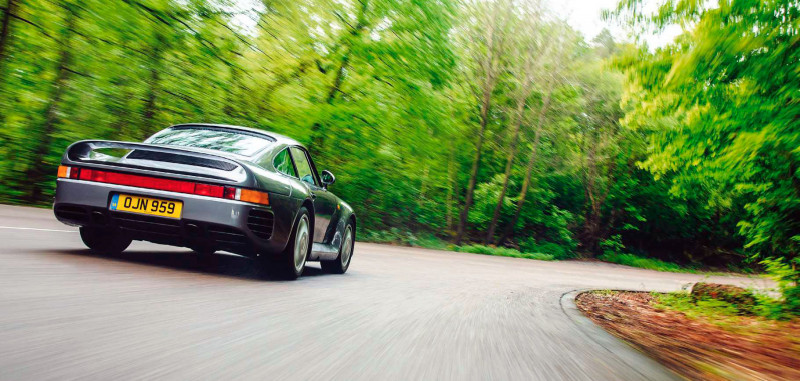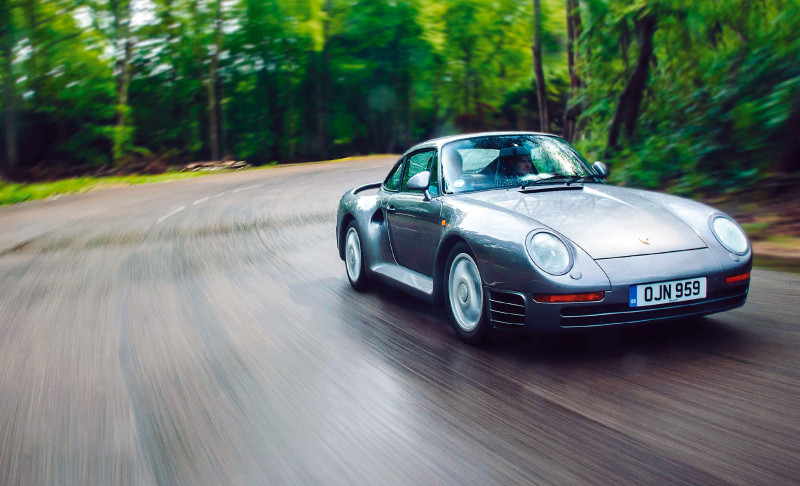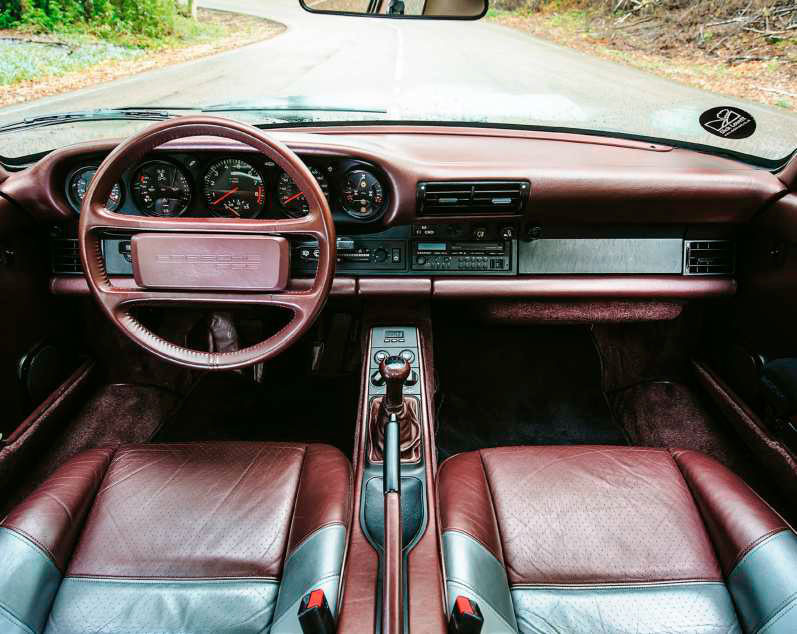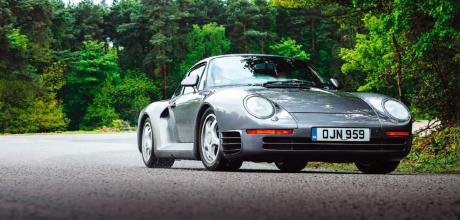1986 Porsche 959
It’s the seminal Porsche superstar that has influenced more than three decades of the 911’s evolution, but can the 959 still cut it today?
The Eighties supercar used tech that’s still used on modern sports cars today
It’s hard to believe the Porsche 959 is more than three decades old. Endowed with truly effortless performance and elegantly styled, it’s the original Porsche supercar (if you think modest of the 930 Turbo), a pioneering machine that has captured the imaginations of car enthusiasts across the globe ever since – and, as we shall find out, mapped significant chapters of the 911’s own evolutionary journey.

Although there is conjecture to the contrary, the 959 is a close relation of the 911 at the very least. With a flat-six engine positioned past the rear axle, its layout is, crucially, the same, and even a quick look around the car will uncover various styling cues from Neunelfers of the time and thereafter. Consider it a Porsche 911 on steroids, then; a relative heavyweight champion of international box office appeal, with only Ferrari’s F40 able to share ring space with Weissach’s seminal creation. The 959 has, like its uncompromising counterpart from Maranello, gone on to define the entire automotive generation of which it hails from, yet for Porsche enthusiasts the story of the car’s beginning is just as captivating.

Originally displayed as a ‘Gruppe B’ concept on its stand at the Frankfurt Motor Show in 1983, Porsche’s new creation was conceived with racing intentions in mind for the 1984 season. However, CEO Peter Schutz and head of Research and Development, Professor Helmuth Bott, had one eye on the future of the company’s sports cars too. Gruppe B rules stipulated at least 200 examples had to be produced for homologation purposes (though interestingly, the car could be raced prior to series production) and Bott was of the principle that if 200 cars had to be made, why not make a thousand? Thus, development of the recently-saved Neunelfer was thrust into the limelight. One of the first new aspects of development was all-wheel-drive. Schutz had watched the Audi Quattro, brainchild of one-time Porsche supremo Ferdinand Piëch, dominate rallies at international level, and early testing of prototypes in the desert encouraged Bott and his team of engineers to explore this further.

A competition concept was duly trialled in the 1984 Paris-Dakar rally, the car running under the internal designation code Type 953. Some trial it was, too: the 953 finished the 12,000-kilometre race in first place, piloted by René Metge and Dominique Lemoyne. However, ever-evolving technologies meant the car was not ready for production, as hoped, by late 1984, or even 1985. The car was clearly becoming quite complex: Bott wanted to create a Porsche for the next ten years, and development of the 959 could never stay in-house. As Randy Leffingwell outlines in The Complete Book Of Porsche 911, Dunlop needed time to create a special tyre capable of prolonged travel at 200mph but which could also run flat for up to 50 miles. WABCO’s ABS system had to be perfected for all-wheel-drive, and Bosch substantially revised its DME to monitor acceleration, braking, steering, traction and suspension loading up to 200 times per second. Bilstein, too, were called upon to develop active shocks that lowered the ride height at high speeds, a first for the automotive industry.
Meanwhile, the appeal of Gruppe B was wavering due to issues over safety; suddenly Porsche’s disposition over the 959 seemed far removed from its initial remit. As Schutz himself said in 2013: “We thought we were going to build a super 911 that could compete in Gruppe B, but the amount of resources we committed got totally out of hand.” The company persevered and the finished article, designed as a high performance car for the road and christened ‘959’, was unveiled at the 1985 Frankfurt Motor Show, two short years after the original, flowing concept. Two variants were offered: the Komfort model was the 959 in its most lavish expression, while the rare Sport came without height adjustable suspension but had a fixed roll cage for additional stiffness. Cloth seats also replaced the standard leather-covered thrones.
In all, 337 units were built, including prototypes, making the 959 one of the rarest road-going production cars Porsche has ever built. However, it took years for any of these cars to reach the United States, ever a key region for the Zuffenhausen manufacturer. It is said that from the outset, Schutz and Bott had decided not to build the car for the US market, owing to the additional costs involved with bringing the car to market. Ultimately, Porsche needed to hand over four examples to US regulators to crash test and, with the company already making a heavy loss on every single unit of this low-production special, the gesture would be impractical at the very least.
Nevertheless, the thesis of the 959 was mesmerising: this luxury supercar achieved a top speed of 196mph, making it the fastest production car of 1986 and a staggering 35mph quicker than the enchanting 3.3-litre 930. And top speed was just the start of it: this ‘super 911’, as Schutz puts it, featured ABS, active all-wheel-drive with adjustable torque split, active suspension with variable ride height and damping, sequential turbocharging, and a super lightweight construction. In 1986! Read through the press material of any new Porsche release and you’ll still find glowing references to such technologies today.
As we said, at the time only the Ferrari F40 could hold a candle to the 959’s unworldly capabilities – but lest we forget, the F40s focus towards competitive use brought with it compromises for its occupants: there wasn’t even room in the cabin for a stereo. Meanwhile in the Porsche 959, a driver could attain near identical performance figures from the comfort of an adjustable, heated leather seat, while listening to the radio situated in a luxuriously decorated cabin regulated by the comfort of air conditioning.
As it happens, Bott’s proclamation that the 959 would be the benchmark Porsche for the next ten years was somewhat short sighted. Thirty years on, a quick glance at contemporary spec sheets sees its performance figures still stand up to the 991-generation of 911 currently gracing showrooms. However, the 959’s legacy goes far beyond that, best proffered by Schutz himself: “I think the engineering in this car has probably touched more of the automotive population in the world since then than any other single automobile.” So, the big question is, what’s it like to drive today?
Approaching the 959 still provides as much of an emotional occasion as it must have conjured back in 1986. The car is a visual delight: imposing with its wide arches and bulky sills, the soft curvatures at its front and around the rear quarters invite intrigue as to the legitimacy of the car’s performance credentials. Evidence of ‘911’ presence is immediately obvious, the windscreen, doors, roofline and pillars seemingly taken from a 3.2 Carrera. Styled by 935 ‘Moby Dick’ design maverick, Dick Soderberg, the 959’s hulking appearance would have you believing this was a two-tonne monster.
However, clever use of an assortment of materials including lightweight aluminium (as opposed to steel) for all doors and lids, Kevlar for the rear wing and quarter panels, and magnesium for the wheels, means the 959 weighs a wholly respectable 1,450 kilograms. To put that figure in context, it’s just over 100 kilograms more than the 930 of the time and, more impressively, some 30 kilograms lighter than the current 991-generation Carrera 4, itself a twin-turbocharged, all-wheel-drive Porsche with active suspension and ABS as standard. The 959 is squat too, though its wide body means it is not overawed by oversized modern Porsche machinery.
Opening and closing the driver’s door (all 959’s are left-hand drive, don’t forget) brings with it the same ‘click’ and ‘clink’ recognisable from entry to 911s of the period and, taking a seat behind the wheel, you’d be forgiven for thinking you’re inside a 3.2 Carrera-come- 964 hybrid 911. Sure, there are no upright fenders immediately visible out the steeply raked windscreen, but the narrow dashboard housing those broadlyspread five dials is taken from a 3.2 Carrera, as is the thin, double-spoked steering wheel protruding from it. Glancing around, there’s a transmission tunnel recognisable from the 964, and Sport seats from the 3.2 Carrera provide a familiar hold at the sides. Door cards are identical to the 3.2 Carrera, too.
It’s eerily similar to a period 911 inside, but look harder and some 959 trickery begins to register. Ahead of the stubby 964-era shifter there are two raised rotational faces, which see to the 959’s adjustable suspension: to the left is damping tuning and to the right is ride height. Then, behind the stalk modulating windscreen wipers to the right of the wheel, there’s a thicker column that sees to management of the all-wheel-drive Porsche ‘Control Coupling’. This now legendary technology is displayed via the far right VDO dial on the dashboard, which distributes torque to the front and rear axles according to driving conditions (regular driving sees up to 80 per cent power going to the back wheels while a 50/50 split is permissible in adverse circumstances). Torque is distributed via a multi-plate wet clutch mounted alongside the front differential. Other gizmos including tyre pressure monitoring do little to distract from the fact the 959 could be some lavish backdate of an otherwise modern supercar.
Firing up the 959 is a veritable treat to the ears. Though it has a flat six hanging aft of the rear axle, it’s surprising just how different it sounds to any other Porsche 911: that customary air-cooled whir isn’t there, replaced by a deeper, gruff note. Its course timbres are perhaps at odds with what is an extremely well-appointed supercar, even if this does hint at the mesmerising fact one Hans Mezger – who else – derived this power plant from that of the Moby Dick 935 race car.
The Type 959/50 engine itself is a work of art. Aside from the twin turbochargers mounted sequentially, it features titanium connecting rods and, of course, fourvalve water-cooled heads (the rest of the engine is, true to a classic 911, cooled by air). The resultant 450bhp at 6,500rpm stands up to a 991 Carrera S today, and the two cars share a 3.9-second 0-62mph sprint time. The 959 is 30 years old now, remember!
What’s most impressive about the 959’s performance though is its power delivery. Far from the rough and unforgiving experience the car’s acoustics on tick-over deceive you into expecting, it’s as sophisticated as the rest of the technology aboard this 1980s rocket ship. The 959 is an able cruiser, retaining a civility about its ride at low speeds. However, with a prod of the accelerator, the 959 demonstrates why it is the fastest car of 1986. There’s no such lag as found in its little 930 brother, the sensation of rapid momentum available instantly. There’s a real surge in velocity as the first turbocharger is called into play from around 1,700rpm, this rush sending the rev needle winding hastily around the tacho. Then, at 4,000rpm, the dormant second turbocharger spools into life, providing car and driver with another hasty kick forward. You can really feel the entry point of both turbochargers on that journey around the tachometer, elevating your pulse rate accordingly as each one kicks in. The sound, too, is something to savour, that gruff note rising into a rich mechanical bark akin to rapid gunfire and utterly consuming the cockpit past 4,000rpm, all the time among a backdrop of whirring turbos. The sound and sensation of speed in the 959 is mesmerising, and I feel my eyes widen and my mouth open as I grip the wheel with one hand and quickly shift up with the other. Delightfully slick, the 959’s gearbox is a worthy aid to its 2.85-litre power plant. It’s technically six-speed, though the ‘G’ gear, found where first gear resides in a traditional G50, is for use only when moving off on uneven terrain. That means for road use the 959 has a dogleg first gear, and the shorter, more concise throw across each gate makes for a pleasurable action later lavished on the manual 964.
Its power delivery and sound are unlike any 911 before or since, and the 959’s handling is decidedly different, too. It’s so assured, that wider track at both axles doing wonders for its road holding. Even at high speed, the car is unperturbed, soaking up occasional bumps in the road thanks to the twin shocks on each wheel. Certainly, there’s nothing particularly crashy about the 959’s intentions to stick to the road, even when the body hunkers down by some 30mm at speeds above 95mph.
There’s a beautifully translucent manner about the steering too, it being power assisted yet perfectly weighted, and grip through turns is constant and plentiful – while pace on exiting a corner is plainly astonishing. The brakes are confidence inspiring, too, allowing me to brake much later into a corner than I would otherwise do. There’s healthy pedal travel to be had and though the bite of those pads isn’t as razor sharp as a car of today, speed is scrubbed with an impressive rate with a firm press of the pedal. The sensation is indicative of the 959 as a whole: it just seems unshakeable, though I’ll admit I don’t push my luck too much to find out the point at which this is likely to be jeopardised.
My overriding thought as I finally climb out of the 959’s cockpit? It’s so endearing as a usable performance machine! Far removed from the edgy spirit of Porsche’s other turbo’d cars of the time, the 959 is positively more explosive, yet its limits seem boundless. Bizarrely, and in contrast to the supercars of today, the 959 utilises its technological superiority in the right way, thrilling rather than overbearing the driver. I put this down to the fact this technology is largely mechanical, rather than digital. The 959 is certainly no aging slouch, its drive still comparable to the current crop of supercar superstars, some of which still utilise its technological concepts. The Porsche 959 is a true pioneer of the automotive world: little wonder, then, that its spirit is evident in the majority of 911s still rolling out of Zuffenhausen today.
“The 959 is certainly no aging slouch, its drive still comparable – favourably, in some cases – to current supercars”
Porsche 918 Spyder: the future of 911 technology?
The 918 isn’t even remotely a derivative of the fabled 911, in difference to Porsche’s supercar of the 1980s in the 959. However, a 911 enthusiast will dismiss the relevance of the 918 at their peril: it’s no secret that Porsche intends to unleash the hypercar’s pioneering E-Performance technology onto future generations of its sports cars, which the 911 is central to. In fact, elements of the 918’s legacy have already filtered through onto the 911’s spec list. The carbon-backed lightweight bucket seats, optional on the 991 GT3 RS and standard on the 991 R, were originally constructed for the 918, and there’s more than a smattering of synergy between the three-spoked steering wheel now found across the range in Gen2 991s and that found in Zuffenhausen’s flagship hybrid hypercar.
It doesn’t stop there, either: the 20- and 21-inch wheels found under the 991 GT3 RS’s arches are identical in size and spec to that of the 918, with matching tyres from Michelin too. Those with a keen eye will note the adjustable front vents on the 991.2 Carrera and S, which close at 10mph and reopen at 100mph to aid aerodynamics and cooling, are also taken directly from the 918. As for its drive, aside from the ludicrous surge in power, it is the 918’s road holding that is simply phenomenal. Unflinching even at very high speeds, its chassis remains glued to the asphalt, the work of various active aerodynamic enhancements at the car’s front, rear and underside. There’s no doubt the 918’s dexterity is aided by its mid-engine layout (a setup that the 911 can never have without conceding its famous moniker) but the canny placing of those batteries and motors around the carbon monocoque tub means the 918 has an exceptionally low centre of gravity, and you can really feel it right through turns.
Switching between V8 and electric power is effortless, too. In, E-Power or Hybrid mode, the first 30 per cent of the accelerator pedal’s travel modulates power from the two electric motors (one mounted on each axle), but push the pedal past the ‘soft’ limiter and the 4.6-litre V8 kicks in seamlessly. You then have additional pedal travel and requisite power at your toes, and switching to Sport Hybrid, Race Hybrid or Hot Lap settings will see those two motors work with the internal combustion engine to provide additional boost and unlock the full might of the 918’s 887hp. Energy recuperation via braking is a clever technology used on contemporary electric cars and doesn’t detract from the 918’s sporty driving dynamics. The sensation of fast propulsion against a backdrop of silence is bizarrely captivating, though this pales into insignificance in comparison to the banshee V8 howl at its 9,150rpm redline.
At face value a driver is confronted by a 3.2-come-964 cabin, but with extra dials and clocks for AWD, ride height and damping.
- Model 959
- Year 1986-1988
Engine
- Capacity 2,850cc
- Compression ratio 8.3:1
- Maximum power 450bhp @ 6,500rpm
- Maximum torque 500Nm @ 5,000rpm
Transmission
- Six-speed manual, four-wheel drive
Suspension
- Front Independent; double wishbone; coil spring; anti-roll bar
- Rear Independent; double wishbone; coil spring; anti-roll bar
Wheels & tyres
- Front 8x17-inch; 235/45/ZR17
- Rear 9x17-inch; 255/40/ZR17
Dimensions
- Length 4,260mm
- Width 1,840mm
- Weight 1,450kg
Performance
0-62mph 3.9 secs
Top speed 196mph


